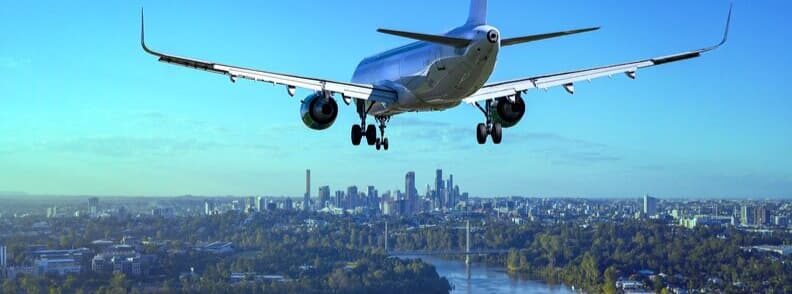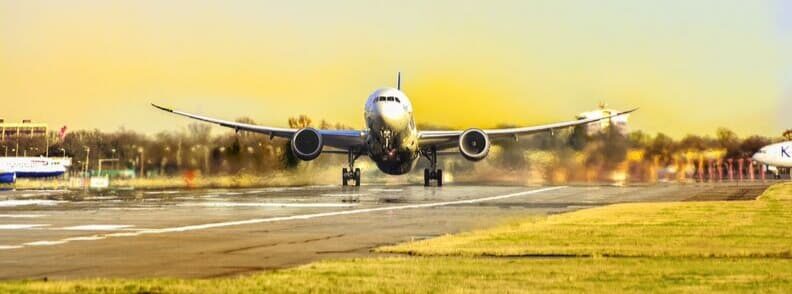Imagine a time when the sky was the ultimate frontier, a realm of birds and clouds, untouchable and distant. A hundred years ago, mankind’s aspirations to soar were confined to the pages of Jules Verne novels and the daring exploits of a few brave inventors. The dream of flight was just that – a dream. Yet, from these humble beginnings, the aviation industry was born, embarking on a journey that would redefine our understanding of space and time.
Born from the crucible of fierce competition among pioneering plane manufacturers in the United States, the birth of the aviation industry marked a turning point in human history. It was an era defined by courage, innovation and an unquenchable thirst for progress. The sky was no longer a dream; it had become a challenge to be conquered.
As the industry took flight, the world watched in awe. The impossible was being achieved every day, and with each new flight record, and each technological innovation, the pace of progress accelerated. Specialized companies from the old continent, Europe, were not just spectators; they, too, joined the race, adding their distinct flair and engineering prowess to the mix.
The skies became a global stage, with jet manufacturers from the sun-drenched beaches of Brazil to the vast landscapes of Australia, from the icy expanses of Canada to the bustling cities of the United States, all striving for supremacy. Each brought their unique strengths and philosophies to the table, and in doing so, raised the bar of what was achievable.
This fierce competition and international collaboration did more than just put airplanes in the sky; they laid the foundation for the modern aviation industry, one of the largest corporate industries today. The trials, tribulations, and triumphs of these early pioneers have shaped the world as we know it, bringing distant lands closer together and making the dream of global connectivity a reality.
The journey of the aviation industry is not just a tale of technological progress; it’s a testament to the indomitable spirit of human ambition. From being a mere fantasy, aviation has transformed into a titan of industry, a story that continues to unfold and inspire.
So, fasten your seatbelts, dear readers, as we embark on a journey through time, charting the transformative path of the aviation industry. From its humble beginnings to its present-day glory, we’ll navigate the ups and downs, the triumphs and trials, and the innovations and inspirations that have shaped the course of aviation history. And, who knows, maybe along the way, we’ll catch a glimpse of where this incredible journey might take us next.
The dawn of aviation – a historical overview
The echoes of World War II had barely faded when the aviation industry experienced an extraordinary boom. This period marked a new dawn in the saga of aviation, a time of rapid growth and expansion that transformed the industry. As the world began to rebuild, people dared to dream again, and those dreams took them to the sky.
The airlines sprouted like mushrooms in a fertile forest, each trying to claim its piece of the sky. Every sunrise brought new routes, new destinations, and new opportunities. The world felt smaller, and the stars seemed closer. The aviation industry was not just growing. It was soaring!
However, as with any story of growth and success, clouds of challenges loomed on the horizon. The early 1980s brought with them a recession that shook the industry to its core. Airlines, once the darlings of the corporate world, found themselves grappling with a harsh new reality. It was a time of difficult decisions and even more challenging executions. The drive to attract new passengers while keeping their loyal clientele became an art of survival.
The playground of the sky turned into an arena where the survival of the fittest was not just a concept but a harsh reality. Bankruptcies loomed like specters, and merges became a necessity rather than a strategy. In these testing times, aircraft manufacturers, the silent heroes of the aviation industry, faced their share of turmoil.
A financial storm swept the manufacturing sector, forcing them to cut down on production and rethink their strategies. These challenges, while daunting, brought about a paradigm shift in the industry. The skies were no longer just a business arena but instead became a chessboard, where every move counted, and every decision could spell triumph or disaster.
Amidst these upheavals, a new force emerged on the horizon – the passengers. Once just consumers, they transformed into pivotal players in the aviation industry’s survival saga. Their contributions, their loyalty, and their choices became the lifelines for airlines struggling to stay afloat. In the eyes of the airlines, passengers were no longer just customers; they were their saviors, their beacon of hope in a stormy sea of challenges.
The story of the aviation industry in the post-World War II era is not just a tale of growth and challenges. It’s a testament to the resilience of an industry that refused to bow down, an industry that innovated, adapted, and emerged stronger from the trials it faced. As we delve deeper into the annals of aviation history, we find that every cloud had a silver lining, every challenge brought an opportunity, and every crisis sowed the seeds for a brighter, stronger future.

Affordable flying – how the aviation industry democratized travel
In a world consumed by wanderlust, the advent of affordable air travel was a game-changer. As the aviation industry navigated its way through the challenges of the early 80s, it was presented with a unique opportunity: to democratize the sky. And thus began a revolutionary era that brought the wonders of the world within the reach of the common man.
The once formidable cost of air travel started to recede, giving way to a new phenomenon: cheap flights. The airlines, in their quest to attract more passengers, started a thrilling competition. The battleground? The best flight deals. This opened a world of possibilities for frequent business travelers and budget explorers alike. The globe became a playground, and flying became everyone’s favorite sport.
With affordable tickets, the horizons expanded, and the world seemed more connected than ever. The thrill of exploring new destinations, the joy of reuniting with loved ones, the convenience of business travel – everything was just a flight away. This was not merely a change in prices; it was a paradigm shift in the way people perceived travel.
But the airlines didn’t stop at just offering cheap flights. They wanted to create a community, a family of loyal customers who would choose them, flight after flight. And thus, the era of frequent flyer programs was born. Airlines went all out to increase their club memberships, offering a plethora of benefits that were much more varied and appealing than today. From priority check-ins and extra baggage allowances to exclusive lounge access and free flight upgrades, the benefits were as enticing as they were varied.
In a surprising turn of events, airlines even joined forces with telephone companies, an unprecedented collaboration that added a new dimension to customer rewards. Switch your phone service, and voila, you were rewarded with bonus air miles. It was a move that turned heads and, more importantly, won hearts.
The era of affordable flying was not just about lower prices and increased benefits. It was about breaking down barriers and making dreams come true. It was about that college student backpacking through Europe, that middle-class family on their first international vacation, and that entrepreneur sealing an overseas deal. It was about ordinary people and their extraordinary journeys. It was about you, me, and the magical world of flying. This era marked a moment in history where the aviation industry truly brought the world closer, one cheap flight at a time.
The expansion metropolises – the small-town airports
The aviation industry, as we know it, has always been synonymous with bustling cities and towering skyscrapers. Airports were seen as gateways to urban jungles, connecting metropolises around the world. But as the wings of the industry expanded, a new trend took flight, forever transforming the landscape of aviation: the rise of small-town airports.
As the world shrunk, distances became less daunting, and more people found themselves living in one city and working in another. For these modern-day nomads, commuting by plane became the norm. The hum of engines replaced the honking of cars, and the sky became their highway. From businessmen closing international deals to academics attending overseas conferences, plane commuting became a symbol of a connected and fast-paced world.
And so, small-town airports began to dot the globe. These quaint, often overlooked airfields played a pivotal role in the expansion of the aviation industry. No longer were airports exclusive to large cities. From the heartland of America to the charming towns of Europe, airports became a common feature, a testament to the growing reach of the aviation industry. The once clear distinction between urban and rural began to blur, creating a seamless skyway that connected every corner of the world.
But the transformation wasn’t just geographical. It was also societal. The image of the glamorous, high-heeled ‘stewardess’ gradually gave way to the more inclusive, professional term ‘flight attendant’. This was not merely a change in nomenclature but a reflection of the evolving values of society. It acknowledged the significant role these individuals played, not just in serving meals and flashing smiles, but in ensuring passenger safety and comfort.
This period witnessed the aviation industry breaking out of its urban shell, reaching out to the smaller towns, and embracing the diversity of its workforce. It was a time when the industry truly took off, not just in numbers but in spirit, transforming the way we perceive air travel.
From the roar of engines in the quiet countryside to the replacement of the term stewardess with flight attendant, the emergence of small-town airports was a chapter in aviation history that embodied growth, inclusivity, and change. It was a testament to the industry’s adaptability and its commitment to bringing the world closer, one small town at a time.

The birth of airport cities – airports become more than just transit hubs
There was a time when airports were little more than utilitarian transit hubs, where passengers lingered reluctantly, longing for their journeys to resume. But as the aviation industry soared to new heights, these spaces too began to evolve, transforming from simple pit stops into sprawling airport cities teeming with life and offering a world of amenities to the modern traveler.
As the skies grew more crowded, the challenges of managing massive air traffic became apparent. It was no longer enough for airlines to operate in their silos; the need for harmonious collaboration and strategic planning grew urgent. The response to this was the birth of large-scale airports, engineered with precision and designed with an eye toward the future.
These were not just airports; they were microcosms of the cities they served. Spreading across vast expanses, they sprawled vertically and horizontally, their architecture reflecting the dynamism of the world outside. Passengers found themselves in the heart of bustling mini metropolises, with an array of dining, shopping, and entertainment options at their fingertips. The waiting game was no longer a drudgery, but an opportunity to explore and indulge.
A new era of luxury dawned as well, as plush lounges opened their doors to those seeking a premium experience. Travelers who chose to invest a bit more were welcomed into serene havens, where they could unwind in comfort and savor top-notch services. It was a taste of the high life, nestled within the bustling atmosphere of the airport city.
But the transformation didn’t stop at catering to adult passengers. The needs of the smallest flyers were taken into account too, with childcare facilities and merry-go-rounds cropping up, turning the airport into a playground where little ones could enjoy their transit time as much as their adult companions.
The rise of airport cities marked a significant turning point in the history of aviation. Airports were no longer just waypoints in a journey but destinations in themselves, filled with opportunities for exploration and enjoyment. As we walked their corridors, we were not just travelers passing through; we were citizens of a vibrant, ever-evolving city that soared as high as the planes it hosted.
From the bustling shops to the luxurious lounges, from the childcare facilities to the merry-go-rounds, every aspect of these airport cities spoke of an industry that had gone beyond merely facilitating travel. It was now enhancing the journey, adding color to the transit, and crafting an experience that started not when we reached our destination, but the moment we set foot in the airport.
Elevating the travel experience – the in-flight revolution
There was a time when the thrill of travel was confined to the destination alone. The journey itself was often seen as a necessary inconvenience, a period of passive waiting to be endured before the real adventure could begin. But as the aviation industry evolved, so did the travel experience. The journey was no longer just a prelude to the destination, but a significant part of the adventure itself. The catalyst for this transformation? The in-flight revolution.
The airplane cabin was no longer merely a vehicle; it was a stage where entertainment, comfort, and convenience were the leading acts. Depending on the length of the flight and the ticket fare, passengers could immerse themselves in a world of in-flight movies, each one with their personal screen acting as their window to various realms of cinematic magic.
But the in-flight revolution did not stop at the silver screen. It understood that diversity was key in catering to the global traveler. For those whose hearts resonated with the rhythm of music, there were radio and music choices at their disposal. Readers found a friend in the in-flight magazines, their pages brimming with engaging stories, informative articles, and captivating images.
As the digital age dawned, the in-flight experience adapted and evolved. It recognized that many passengers were digital nomads, their lives intertwined with their electronic devices. To cater to this new breed of travelers, planes were equipped with USB plugs, ensuring that low batteries and disconnected devices were worries left on the ground.
The in-flight revolution was not just about entertainment; it was about understanding and adapting to the needs of the modern traveler. It was about ensuring that the journey was as exciting, comfortable, and productive as the destination.
The aviation industry had effectively transformed the airplane cabin into a world of its own. A world where time flew by, where miles disappeared not in a void of waiting, but in a space filled with entertainment, comfort, and connectivity.
As we buckle our seat belts and settle into our seats, we are no longer simply passengers on a journey. We are the audience in a unique show, a show where the in-flight experience is the star, and the cabin is the stage. And as the engines roar to life, we know we’re not just on our way to our destination; we’re already on an adventure.
Taking flight – charting the evolution and future of aviation
As we disembark from this narrative journey, let’s take a moment to marvel at the transformative voyage of the aviation industry. A century ago, the thought of traversing the globe through the skies was nothing more than a fantastical dream. Today, it’s a reality so commonplace, we scarcely pause to marvel at it. But this evolution of aviation didn’t just happen overnight. It was a gradual, yet persistent, metamorphosis that forever changed our perception of distance and time.
Looking back, it’s incredible to realize how much the industry has morphed, adapting to the demands of a diverse and ever-evolving demographic of travelers. It has bridged gaps, connected corners of the globe, and made the world a smaller place, all the while transforming the travel experience itself.
From the rise of small-town airports to the advent of in-flight entertainment, the industry has consistently redefined the norms of travel. And as affordable flying became more accessible to everyone, it revolutionized not just how we travel, but who could travel.
Yet, the aviation industry recognizes that its journey is far from over. As the world becomes more conscious of the environmental impact of human activities, the industry is rising to the challenge. Balancing the need for affordable, long-haul flights with a commitment to reducing carbon emissions is no easy task. Yet, if the past is any indication, the industry is well-equipped to navigate this new frontier.
As we stand at the precipice of this exciting new era of aviation, one can’t help but anticipate the changes that lie ahead. Just as we have watched airports transform into bustling microcosms of cities and planes evolve into havens of comfort and entertainment, we eagerly await the next phase of innovation. And while we can’t predict exactly what the future holds, we can say with certainty that the aviation industry will continue to amaze us.
So, fasten your seat belts, fellow adventurers. As we take off into the future, rest assured that the journey is sure to be as thrilling as the destination.

Mirela Letailleur from the capital of Romania, has crafted a life around her passion for exploring the hidden gems of Europe, all the while calling the picturesque South of France her home. As the creative force behind The Travel Bunny, Mirela masterfully blends her love for adventure with an innate ability to make travel both affordable and accessible. A problem-solver at heart, she creates bespoke travel guides that are as unique as the travelers who follow her, and with a knack for unveiling local secrets, she’s become a trusted travel expert in the online community.
When it comes to the aviation industry, Mirela’s insights are unparalleled. Her experience and keen understanding of travel trends lend her a unique perspective that she generously shares with her readers. Whether she’s decoding the evolution of airports into mini-cities or discussing the latest in-flight entertainment, Mirela’s advice is a beacon for both novice and seasoned travelers. Her charm is not just in her expertise, but also in her ability to make complex industry trends comprehensible and engaging for her readers. So, if you’re looking to navigate the intricacies of the aviation industry, Mirela Letailleur is the travel guru you’ll want to have in your corner.
After learning about the aviation industry history, check out these travel articles on The Travel Bunny blog
Airline travel lingo explained
How to find cheap plane tickets to anywhere
How to sleep on a plane. Tips to beat jet lag

